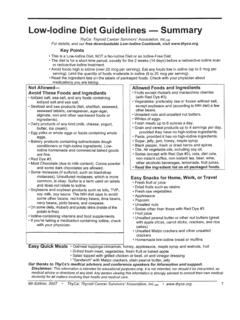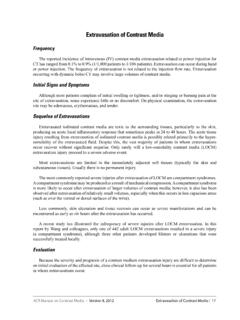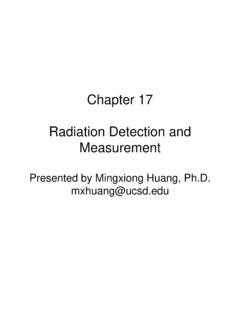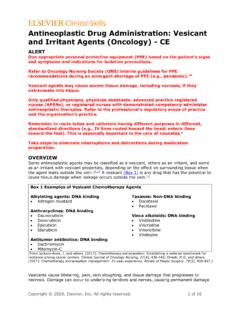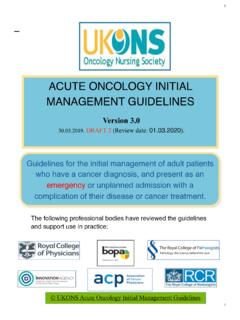Transcription of Contrast Media Guidelines UPDATED 18Jun2014
1 UC San Diego Health System Intravenous Contrast Media Guidelines Adult Approved by P&T Committee 6/18/2014 Policy Statement To establish Guidelines for the prevention, diagnosis and treatment of Contrast Media reactions after intravascular injection, and to reduce the chance of inducing Contrast Media nephrotoxicity. Responsible Parties Physicians, Medical Trainees, Radiologic Technologists, Nurses, Students, Technical Assistants PROCEDURE I. Intravenous Access When the power injector is utilized, a 22 G or larger needle/cannula to length is preferred for IV Contrast injection. It is advisable to obtain a good backflow of blood to test adequate positioning of the needle in the vein. Adequate position of the cannula in the vein is checked again, by flushing IV with 10mL of saline flush into the vein before delivering the injection of Contrast .
2 Use of existing access routes: 1. Only power-injection rated PICC or central lines are approved for power injection. 2. Pre-existing IV lines will be flushed with 10 mL of saline flush, to ensure patency, prior to Contrast injection. 3. Port-a-cath to be accessed by or Physician, with training. If no trained staff is available, send patient to the Infusion Center or Cancer Center. 4. Consult Physician/ RN prior to using any central line catheters. If not power rated, the injection must be hand injection. IIa. Prevention of Nephrotoxicity with Iodinated Contrast Media Requirements for CREATININE and Glomerular Filtration Rate (GFR) (if available) testing prior to Contrast Media injections (for the purpose of reducing the chance of Contrast -induced renal failure) A. Patients > 60 years of age are to have a recent (within 6 weeks) serum Creatinine prior to Contrast injection.
3 If there has been significant interval change in the patient s condition, a more recent serum Creatinine should be obtained. B. Patients <60 years of age do not require labs, UNLESS the patient has one or more of the following: History of renal disease or surgery on the kidneys: Including dialysis, kidney transplant, single kidney, kidney surgery Diabetes mellitus History of Hypertension Renal Cancer Recently (within 3 months) had chemotherapy Intravenous Contrast Media Guidelines - Adult 2C. When clinical findings or history raise doubt about the patient s current renal function, a physician will order a STAT Creatinine/eGFR test which should be done prior to injecting Contrast Media . D. IODINATED Contrast AGENTS (Both ionic and non-ionic Contrast agents): If the serum creatinine is > mg/dL or GFR is < 50 mL/ , the physician will be notified.
4 If the creatinine is > in a diabetic patient, > 2 in a non-diabetic patient, or the GFR is < 30, and the referring physician and physician ( , radiologist) have determined that a Contrast -enhanced imaging study must be done to obtain critical medical information, the Contrast may be given after considering the following precautions: 1. Discuss the risks, benefits, and alternatives with the patient. 2. Adequate patient hydration must be maintained (See Section E). 3. Optional treatments include the following: a. Mucomyst (N-acetylcysteine) orally, 600 mg twice daily on the day before and the day of the Contrast imaging study, OR b. Bicarbonate 150 mEq in 1000 ml D5W, IV, 3 mL/kg bolus, then 1 mL/kg/hr x 6 hours. For patients with end stage renal disease who are on chronic peritoneal dialysis, non Contrast should be considered and Contrast should only be administered after discussion with the patient's nephrologist.
5 This conversation must be documented. E. Adequate patient hydration is important to minimize the risk of nephrotoxicity. No patient receiving radiographic Contrast should have NPO orders unless they are being properly hydrated with IV fluids. Patients having a CT with oral Contrast should have nothing solid 4 hours prior to the exam, but clear liquids are allowed up until the exam. If the patient cannot take adequate oral fluids, consider adequate intravenous hydration. F. All patients should be encouraged to drink lots of fluids for several hours after receiving Contrast material. G. Patients taking Metformin (ACTO plusmet, Avandamet, Janumet, Fortamet, Glucovance, Glucophage, Glumetza, Riomet, Metaglip, Jentadueto, Kombiglyze, PrandiMet): 1. Patients taking Metformin should not take the medication following the procedure.
6 The medication should be withheld for 48 hours after the procedure and reinstated only after clearance by the patient s ordering doctor. H. No other medications should be stopped for patients received radiographic Contrast Media . Important, unless specifically instructed by their physician, patients should continue taking their regular prescribed medications for diabetes (Insulin, etc), cardiac, and other medical conditions. IIb. Use of Gadolinium Based Contrast Agents in Patients with Renal Insufficiency or Failure Gadolinium-based Contrast agents using a standard dose ( mL/kg [ mmol/kg]) are very safe in patients with normal renal function. However, Gd-based Contrast agents have been implicated in causing Nephrogenic Systemic Fibrosis (NSF). Reported cases were patients with severe Intravenous Contrast Media Guidelines - Adult 3renal dysfunction (on dialysis or eGFR < 30 mL/min), and most patients received double or triple doses of gadodiamide (Omniscan, Amersham/GE).
7 Therefore, we have set the following Guidelines for giving Gd-based Contrast agents. Requirements for CREATININE and GFR testing prior to Contrast Media injections: A. Patients > 60 years of age are to have a recent (within 6 weeks) serum Creatinine and GFR prior to Contrast injection. If there has been significant interval change in the patient s condition, a more recent serum Creatinine and GFR should be obtained. B. Patients < 60 years of age do not require labs, UNLESS the patient has one or more of the following: History of renal disease or surgery on the kidneys: Including dialysis, kidney transplant, single kidney, kidney surgery Diabetes mellitus History of Hypertension Renal Cancer Recently (within 3 months) had chemotherapy C. If GFR is > 30 ml/min, then gadolinium can be given. It is important to avoid the use of Omniscan, Magnevist, and OptiMARK in high risk patients.
8 If GFR is < 30 mL/min, DO NOT give gadolinium unless in the judgment of the radiologist, the anticipated benefits exceed the potential risks. If both the physician and referring physician decide that Contrast -enhancement is necessary, the Gd-based Contrast agent can be given with the following precautions: 1. Discuss the risks, benefits, and alternatives with the patient. 2. Obtain signed consent from the patient. If patient is unable to give consent, follow Medical Center policy regarding informed consent. The physician must write the order for gadolinium, including the specific agent, dose, and reason for taking the risk. 3. Dose at no more than ml/kg ( mmol/kg). Use half dose if adequate for the MR study. D. Patients who are on dialysis: The clinical indications for the study should be assessed. If gadolinium is not necessary, a non- Contrast study ( , MRI) should be performed, and the referring physician should be informed about the change in the ordered exam.
9 If gadolinium might be helpful, the referring physician should be called to discuss the risks and benefits of giving gadolinium to the patient. If both the physician ( , radiologist) and referring physician decide that Contrast -enhancement is necessary, the Gd-based Contrast agent can be given following the Guidelines in section C above. In addition, hemodialysis should be done as soon as possible after the scan (ACR Guidelines ). E. Any patients receiving double or triple doses of Gd-based Contrast agent should be screened with serum creatinine and eGFR: 1. If the GFR is normal, then the double or triple dose of gadolinium can be given. 2. If the GFR is not normal but > 30 mL/min, no more than single dosage should be given. 3. If the GFR is < 30 mL/min, DO NOT give gadolinium unless absolutely medically necessary, following Guidelines in section C above.
10 Intravenous Contrast Media Guidelines - Adult 4 III. Allergic Type Contrast Reaction Prevention A. For patients receiving iodinated or gadolinium Contrast Media , obtain a complete history of any prior reactions to dyes or Contrast used in X-ray, CT, or MRI. 1. The patient is to fill in the questionnaire (Patient Questionnaire- Contrast D322). 2. The technologist or licensed staff is to review the questionnaire with the patient prior to injection. 3. The questionnaire is part of the patient s medical record. The technologist is to complete the information regarding type and volume of Contrast and reactions, then sign questionnaire, post injection B. For patients receiving iodinated or gadolinium Contrast Media , pre-treatment to prevent or lessen reactions should be given under the following Guidelines : 1. Patients with history of Prior moderate or severe Contrast reaction Severe asthmatics with active wheezing or acute shortness of breath C.

